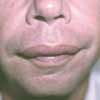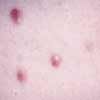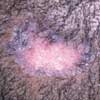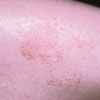- Clinical Technology
- Adult Immunization
- Hepatology
- Pediatric Immunization
- Screening
- Psychiatry
- Allergy
- Women's Health
- Cardiology
- Pediatrics
- Dermatology
- Endocrinology
- Pain Management
- Gastroenterology
- Infectious Disease
- Obesity Medicine
- Rheumatology
- Nephrology
- Neurology
- Pulmonology
Angioedema and Dermatofibromas
fill this in

Case 1:
A sudden swelling of the lips prompts a 54-year-old man to seek medical attention. He takes no medications and is unaware of any precipitating factors.
Which of the following have been associated with angioedema?
A. Shrimp.
B. Peas.
C. Bananas.
D. Grapes.
E. Potatoes.
Bonus question 1: Which of the above foods has been associated with latex allergy?
Bonus question 2: Which of the above foods cross-reacts with peanuts?
(Answer on next page.)

Case 1: Shrimp, peas, bananas, grapes, and potatoes have all been associated with angioedema. An allergist can help determine which foods are responsible in a particular case.
Answer to bonus question 1: Bananas.1
Answer to bonus question 2: Peas.2
REFERENCES:1. Garcia Ortiz JC, Moyano JC, Alvarez M, Bellido J. Latex allergy in fruit-allergic patients. Allergy. 1998;53:532-536.
2. Wensing M, Knulst AC, Piersma S, et al. Patients with anaphylaxis to pea can have peanut allergy caused by cross-reactive IgE to vicilin (Ara h 1). J Allergy Clin Immunol. 2003;111:420-424.

Case 2:
For several months, a 47-year-old woman has had asymptomatic pigmented nodules on her thighs. She has a several-year history of systemic lupus erythematosus (SLE), which has been well controlled with an oral antimalarial agent. She is concerned about the rash and wonders whether it is related to her SLE.
What is your clinical impression?
A. Adverse reaction to the antimalarial agent.
B. Nodular vasculitis.
C. Sarcoidosis.
D. Dermatofibromas.
E. Folliculitis.
(Answer on next page.)

Case 2: This patient has dermatofibromas, D, lesions that are sometimes associated with SLE.1 No treatment is necessary for this benign condition.
An antimalarial would not produce this type of reaction. Nodular vasculitis and folliculitis are symptomatic. Sarcoidosis may be ruled out by biopsy.
REFERENCE:1. Massone C, Parodi A, Virno G, Rebora A. Multiple eruptive dermatofibromas in patients with systemic lupus erythematosus treated with prednisone. Int J Dermatol. 2002;41:279-281.

Case 3:
Almost 2 years ago, a 28-year-old man noticed a round hairless patch on his scalp after he shaved his head. At the time, the patient thought he had sustained an injury to the site. The asymptomatic, solitary lesion has not changed since it first appeared. The patient takes no medication.
What is the most likely cause of the lesion?
A. Alopecia areata.
B. Secondary syphilis.
C. Discoid lupus erythematosus.
D. Sarcoidosis.
E. Seborrheic dermatitis.
(Answer on next page.)

Case 3: The patient has discoid lupus erythematosus (DLE), C. Closer examination revealed a similar lesion inside one ear that the patient had been unaware of. The presence of atrophy, scaling, and an erythematous border supports the diagnosis of DLE in the absence of a biopsy. If there is any doubt about the diagnosis, a biopsy is recommended.
Alopecia areata is not associated with erythema and therefore can be ruled out. Secondary syphilis is characterized by multiple lesions. Neither sarcoidosis nor seborrheic dermatitis is associated with atrophy or alopecia. Systemic lupus erythematosus was excluded by blood testing and physical examination.

Figure A

Figure B
Case 4:
A 25-year-old woman presents with a 1-week history of an asymptomatic, nonblanching macular eruption. Some lesions appear in a circular pattern; others are sparsely scattered on the extremities. She has taken an oral contraceptive and vitamin supplements for several years and is otherwise in good health.
What is the most likely cause of this eruption?
A. Erythema multiforme.
B. Fixed drug eruption.
C. Urticaria.
D. Majocchi disease.
E. Insect bite reaction.
(Answer on next page.)

Figure A

Figure B
Case 4: The nonblanching macular rash is typical of Majocchi disease (purpura annularis telangiectodes), D, a rare, benign capillaritis seen in young adults. This self-limited eruption resolves spontaneously in weeks or months, so the only treatment necessary is reassurance. The cause is unknown, and the rash may recur. Erythema multiforme, fixed drug eruption, urticaria, and insect bite reactions are all raised and either painful or tender.
